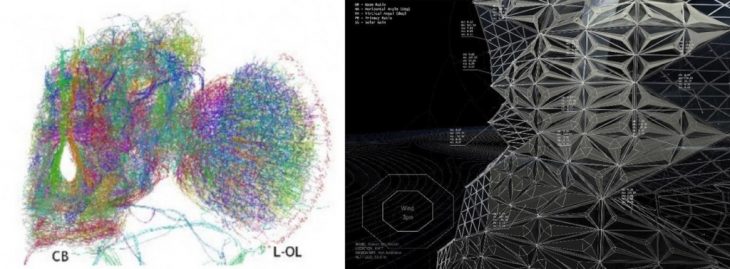RS3 – Research Studio 3
DIGITAL MATTER – INTELLIGENT CONSTRUCTIONS
Senior Faculty: Areti Markopoulou
Fabrication expert: Alexandre Dubor
Computational expert: Angelos Chronis
–
Keywords: responsive architecture, adaptive structures, active materials, buildings that think, material intelligence, artificial intelligence, digital fabrication
Architecture is today facing new challenges. The technological revolution of the Information Era and the advancement of digital manufacturing have brought new concepts to architecture. The physical space intertwines with the digital content and the electronic and physical connections become one.
Buildings are becoming computing machines, both as performative input/output protocols as well as programmable at the material molecular/nanoscale level. Buildings are also starting to become artificially intelligent, thorough machine learning and evolutionary algorithms.
We are consequently moving towards a different form of “habitats”, where architecture is not merely inhabited, but becomes technologically integrated, interactive and evolutional.
Such Architecture is the expression of the Experience Age, characterized by high levels of physical interaction and emotional involvement.
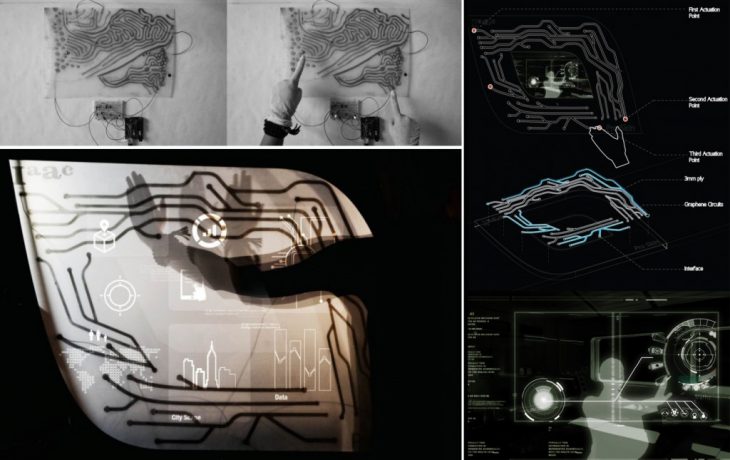
MAA 2015-16 DIGITAL MATTER
PRO_SKIN graphene // I. Ramirez,R.Staples,B.Paksoy,C.R.Naagendran.
By incorporating responsive technologies into the building systems, architects have the ability to tie the shape of a building directly to its environment or to its users needs. This enables us to reconsider the way we design and construct space not towards purely aesthetic creations but exploring “responsive architecture as the natural product of the integration of computing power into built structures” [1]. The next architectural design, then, is the one of enabling the design of relationships, behaviours and modes of operation that endures beyond construction.
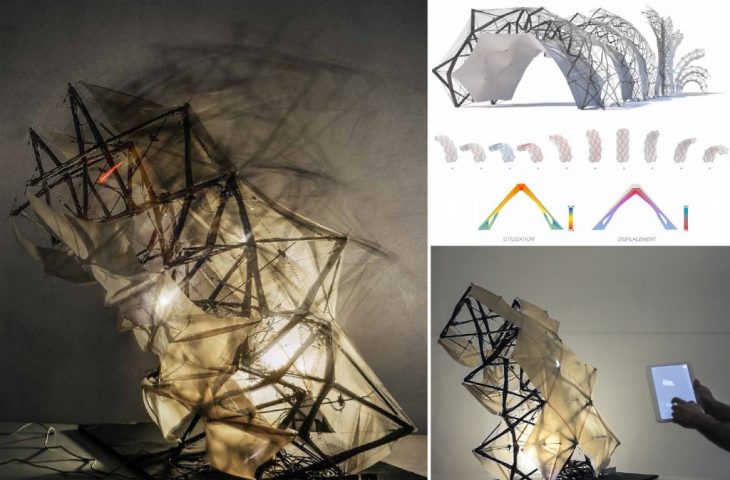 MAA 2014-15 DIGITAL MATTER
MAA 2014-15 DIGITAL MATTER
REMEMBRANE // Ji Won Jun, J.Alcover, M.Silverio
The key, thus, to 21st century challenges generated by global urbanization, economic instability and particularly the increasing awareness related to the environmental crisis will be the development of high efficient “products’ with increasing levels of functionality. Architecture following every stage of life will have to address and respond to both challenges and advancements. Our buildings and cities will need new interfaces to communicate with the environment and embedded systems of performance that do not rely on existing urban infrastructures. Active materials will play a critical role in this development, forcing architects to get free from mechanical actuators or computing devices and integrate into their designs the inherited functions that “smart materials” present on a molecular scale.
At the same time, advanced digital manufacturing techniques allow us to digitally fabricate new material systems and building components with varied properties of density, translucency, elasticity and much more. This brings another level of sustainability awareness, one that questions concepts of durability or longevity and brings forward concepts of dynamics, adaptability and metabolism.
Should we continue constructing rigid and fixed structures?
Or can buildings and cities begin to think?
Understanding the significant need of generating the production of non-rigid, responsive and multi-functional material and construction systems, the Digital Matter Research Line develops case studies on digital and computed matter, exploring intelligent construction systems to be applied at architectural scale.
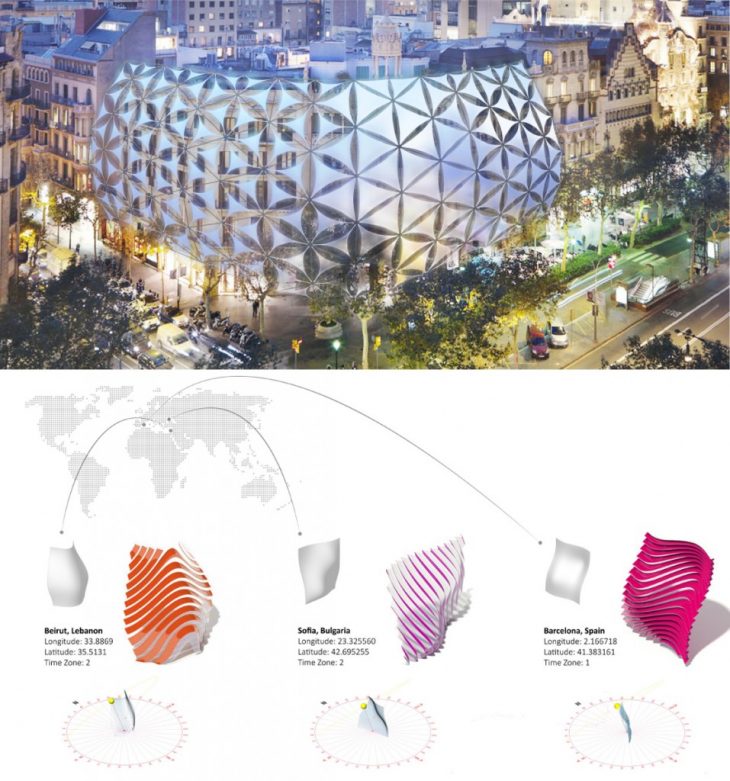
MAA 2013-14 DIGITAL MATTER
CHROMATICSKIN thermocromics // C.Bausa, H. Kovachev, S. Bashirä
In collaboration with the Smart Materials Group of the Italian Institute of Technology [2] as well as experts in adaptive/computed architecture and material scientists, Digital Matter sets up a multidisciplinary team for developing the new designs, and building protocols for Responsive Architecture.
Students will be working with smart and active material systems with a particular focus on Design and Building.
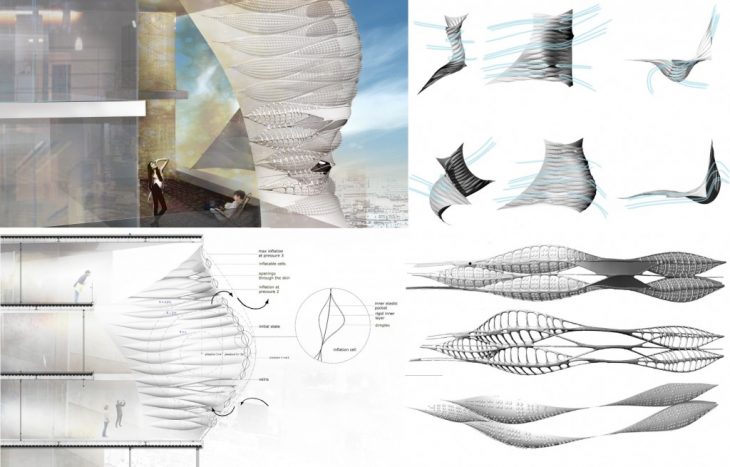 MAA 2013-14 DIGITAL MATTER
MAA 2013-14 DIGITAL MATTER
SOFTSKIN // C.Temel, F.Alayeli, L. Alayeli, N.Jotanovic
Digital design and physical prototypes of Buildings, Skins and Structures that are able to think, actuate, respond to thermodynamic forces and interact with users needs will be the outcome of the final projects.
Computational design for dynamic geometries, physical computing, artificial intelligence and environmental and thermodynamics simulations will be the tools to generate the Responsive Designs and Prototypes. Digital fabrication with a focus on robotic and additive manufacturing (3d printing) will be explored for the construction of the novel intelligent building systems.
The method of investigation follows a rigorously experimental approach and progresses in complexity from small scale material sampling to the production of 1:1 scale architectural components and prototypes.

MAA 2015-16 DIGITAL MATTER
PielVivo BIOPLASTIC // N. El-Gewely, L. Tayefi, C. Wong
___________
[1] Negroponte, N.: Soft Architecture Machines, Cambridge, MA: MIT Press, 1975[2] The Italian Institute of Technology (IIT) is a scientific research centre based in Genoa (Italy, EU). Its main goal is the advancement of science, through projects and discoveries oriented to applications and technology.
[DMIC] 2016-17 GUEST PROFESSORS
Athanassia Athanassiou, Ilker Bayer // Material Scientists (along the year)
Manuel Kretzer, ETH-CAAD // Architect,expert on smart materials (Workshop December, 2016)
Marcos Cruz // Architect, (Guest tutor-Desk Crit February 2017)
Rachel Armstrong // Architect, expert on materials (Guest tutor-Desk Crit March 2017)
Skylar Tibbits // Architect, MIT Self Assembly Lab, (skype session, April 2017)
more to be announced along the academic year
[DMIC] 2016-17 RESEARCH TRIP
Japan, Tokyo and periphery
DATES: 18th-25th February, 2017
All students are expected to check if they need VISA and make the arrangements to acquire it on time. Students will cover all their travel expenses for the research trip.
////
[DMIC] SEMINAR TERM II- MEGA MATTER WORKSHOP
Dates: 19th -22nd December, 2016
Key words: adaptation, smart materials, responsive environments, conductivity, elasticity, memory, 3d printing, dynamics, biology, evolution.
Digital Matter Research will start with the organization of a Mega Matter intensive workshop of 4 days. The objective is to explore active materials and understanding the possibilities of developing dynamic architectural proposals. Mega Matter Workshop will introduce a series of “smart materials” such as graphene, polymorphs, carbon fiber composites, temperature-sensitive and/or electroconductive materials for 3d printing.
Can buildings and cities perform as environmentally integrated living organisms?
Can digital fabrication and additive manufacturing contribute in the production of new responsive material composites?
Is living technology the future of an alive architecture in sync with the environment and the users needs?
The Mega Matter Workshop consist of 4 one-day workshops conducted by different invited experts and it will introduce to the students both the theoretical and practical framework of Digital Matter.

Graphene nanostructure // Material manipulation // Material inner structure
Workshop 1: Polymorphs and Bioplastics.
Faculty: Manuel Kretzer, Christine Baumgartner, Materiability research network, Architects
Date: Monday, December 19th, from 10.00 to 20.00
Within this workshop we will physically explore the potential of using water, gravity, heat, air and other natural forces as tools to mould sinuous surfaces and forms from a biodegradable polyester named Polycaprolactone. PCL, also known as Polymorph is hard and tough when cold but thermally deforms once heated above 60°C. Additionally we will be using (thermochromic) pigments to further enhance the appearance and properties of the material. Navigating our materiality on the narrow path between chance and control we will study questions of scale, continuity and inversion. Throughout the workshop participants will learn about the material’s distinctive properties, try various ways of enhancing them and finally create complex three-dimensional surfaces that we will later combine into a larger, space-defining composition.
Workshop 2: Graphene based Materials.
Faculty: Giovanni Perotto, Athanassia Athanassiou, Ilker Bayer, Italian Institute of Technology, Material Scientists
Date: Tuesday, December 20th, from 10.00 to 20.00
Since graphene’s isolation in 2004 it has captured the attention of scientists, researchers and industry worldwide. Graphene has many extraordinary properties. It is about 100 times stronger than the strongest steel. It conducts heat and electricity very efficiently and is nearly transparent. It is considered to be the material of the future in different applications such as lightweight structures, water purification technology, energy generation and storage, wearable technologies among others. During the workshop we will introduce the material as well as a special composite developed at the IIT that it will be available to the students of Digital Matter for using it in their architectural proposals during their 6 month Research Studio.
Workshop 3: BioComposites and Carbon Fibers
Faculty: Carlos Sáez Comet, Material and Mechanical Engineer
Date: Wednesday, December 21st , from 10.00 to 20.00
The goal of the workshop is to familiarize the students with the general properties, design, processing methods and applications of biocomposites, with a special focus on the architectural domain. After three general theoretical blocks on introduction, processing methods and design, the students will go hands-on through the manufacturing process of a simple biocomposite or carbon fiber composite part, therefore learning the particularities associated to these types of materials and their processing methods associated.
Workshop 4: Theory and Applications
Faculty: Areti Markopoulou, Alexandre Dubor, Angelos Chronis
The last day workshop will be focused on the theoretical discourse related with the basic principles of responsive architecture, dynamic systems and adaptability. The theoretical sessions will cover three main blocks: a. Responsive Architecture, b.Dynamic Geometries and c. Artificial Intelligence. Sessions of presentations, readings and discussions will take place so that students get a deeper understanding of the pioneer research background they will be developing in the following 6 months.
////
[DMIC] SEMINAR TERM II
ENVIRONMENTAL ENGINEERING AND DESIGN
Dates: Feb-March 2017
The Environmental Engineering and Design Seminar will focus on understanding and integrating fundamental thermodynamic and physics phenomena and their impact on the built environment, through environmental analysis and simulation.
Through a variety of simulation and analysis software and cutting edge integration tools the seminar aims to integrate cutting edge environmental optimisation in our projects.
External tutors from the best environmental design groups, such as the Environmental Engineering group of Foster+ Partners ate expected visit and give tutorials during the seminar.
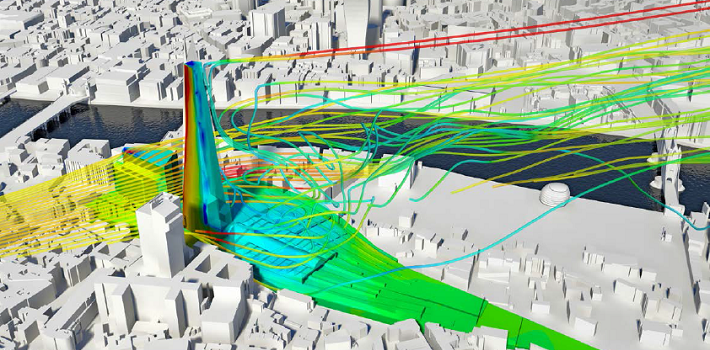 Parson Brinkerhoff // WIND ENGINEERING AND MODELLING
Parson Brinkerhoff // WIND ENGINEERING AND MODELLING
////
[DMIC] SEMINAR TERM III
ARTIFICIAL INTELLIGENCE & CONTROL
Dates: May 2017
Artificial Intelligence is already groundbreakingly transforming our digital lives. Its integration in the built environment is expected to change the way we understand and experience space and architecture.
This seminar will introduce fundamental AI algorithms and methods, such as agent simulations, machine learning, artificial neural networks and genetic algorithms to enable intelligent control and optimisation of our proposed building systems.
Using the latest advancements of AI integration in computational design we aim to make our buildings adaptable to ever changing and unpredicted conditions.
